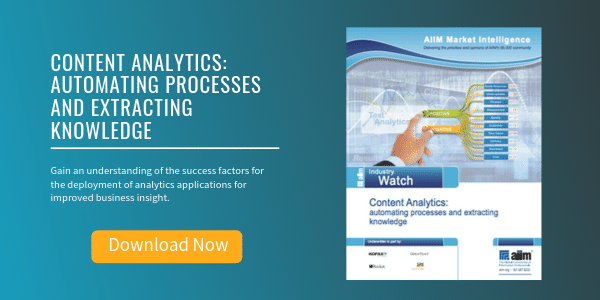
Confused about Content Analytics? 5 Implementation Tips
Content Analytics has hit the industry in a big way. According to our research, over 75% of enterprises say that there is real value to be gained from content analytics -- in business insight and risk mitigation.
This new technology is rightly taking its place amongst the corporate toolset, but that same research study shows mixed progress for implementation. Business insight (or big data / big content) projects are still in something of an early-adopter phase. However, interest and adoption for recognition and routing of inbound content, automated classification of records and email, metadata addition and correction is rising.
To help clear up the confusion and fear of implementation, let's look at the tip implementation tips for Content Analytics.
Tip #1 - Address data structure, tagging, and permissions as close as possible to the point of creation.
Organizations often take the easy option when it comes to content tagging and permissions, figuring that they will get to it “sometime.” However, it really helps to address these issues as soon as you possibly can.
Thornton May: “CSIS (the Canadian NSA) has categories and rules to label data as it comes in -- every paragraph is labeled separately. Labeling data on the way in makes information management more difficult to implement initially, but ultimately easier to consume and manage.”
Russ Stalters, CEO, Clear Path Solutions Inc.: “You need a defined information and data on-ramp so that you have deliberate and controlled data ingestion process. This is critical to ensuring the quality of the underlying data used for content analytics.”
Theo Priestly believes that organizations need to adopt a “Blockchain” approach to security. AIIM defines Blockchain as a “type of distributed ledger that can be used to create an authoritative record of events, which in turn can be used to provide trust within an untrusted environment. Blockchain works by creating a digital ledger of transactions. Each transaction, or block, is recorded in the ledger; even the changing of a single character in a much larger digital transaction will result in the creation of a new block. This ledger, or chain of transactions, is then distributed among all participants in the network, and each participant has an exact copy of the entire ledger.”
Priestley believes that a Blockchain approach has these advantages:
- Storage Cost - An autonomous decentralized storage system would reduce the cost of storage
- Security - Client-side encryption will always beat server-side
- Speed - The scale of a true decentralized P2P network would be vastly superior to a centralized server
Tip #2 - Define a clear set of corporate objectives for content analytics initiatives.
Deciding what you want to achieve before embarking on ANY project is basic business, yet it doesn’t always follow that that will happen. Two of our ELC participants had strong advice on defining corporate objectives for your content analytics objectives.
Jane Alexander, CIO, Cleveland Museum of Art:
- Ensure your backend systems are flexible and interoperable
- Your key data for artwork must be clean, current, and represent one version of the truth
- No one-off projects
- Think of everything in terms of the BIG PICTURE
- Content reuse - repurpose content created for other purposes
Pamela Click, Divisional CIO - CSEB Technology, TIAA-CREF:
- Customer Perspective: Identify the “why” vs. the “what”
- Employee Perspective: Improve productivity; increase job satisfaction
- Generate and retain customers
- Generate revenue
- Brand recognition
- Not just metrics - - behaviors
Tip #3 - Remember that the hardest part of a content analytics project is not the technology.
Sourcing the right technology to achieve your goals is actually one of the easier elements to content analytics. What you must really never forgot is the people element.
Jane Alexander, CIO, Cleveland Museum of Art: “The hardest part of linking silos was the people aspect. The pace was slow, reluctance was hard to deal with, and unrealistic expectations that things should not/could not move that fast.”
Jeremy Phillips, COO, EditorEye: “Content nirvana takes different forms depending on your role in the organization, and content analytics is key to delivering this value. Power users seek to share the flow of content, help colleagues out most efficiently, and control costs. The average end-user, though, prefers to view content analytics as magic, mysteriously delivering the right stuff to them when they need it without needing to do anything. 90% of the users in any group fit in this latter category.”
Tip #4 - Done right, content analytics should drive you to rethink the questions you ask about your organization.
The insight that content analytics can generate will not only provide you with the answers to the questions you ask of your organization, but it will also help make the questions even more pertinent, making the next set of answers even more insightful.
Steve Lohr, New York Times: “Defining problems more expansively is part of the design-thinking ethos. At a course in New York recently, a group of IBM managers were given pads and felt-tip pens and told to sketch designs for ‘the thing that holds flowers on a table’ in two minutes. The results, predictably, were vases of different sizes and shapes. Next, they were given two minutes to design ‘a better way for people to enjoy flowers in their home.’ In Round 2, the ideas included wall placements, a rotating flower pot run by solar power, and a software app for displaying images of flowers on a home TV screen.”
Tip #5 - Position your content analytics initiatives as a means to both enhance customer value AND address information security -- and get the buy-in of business stakeholders EARLY.
Content analytics is not necessarily a silver bullet for all an organization’s key challenges, but it does have value beyond enhanced customer value. The ELC meeting focused a lot on the value and insight to be derived, but content analytics also has a significant role to play when addressing information security.
Mark Roboff, Executive Evangelist, IBM Watson: “My view is that it is a mistake to position content analytics as an ECM tool. Analytics needs to be understood in the context of a business problem and with a clear understanding of how and why they want/need analytics. Content analytics should not be part of an ECM sale alone; it requires analytics expertise and should be part of a larger analytics implementation.”
Dennis Devlin, Co-Founder and CISO, SAVANTURE: “I am a recovering information risk management professional. Information risk used to be a lonely profession. But now I have new friends -- in Business Intelligence, Compliance and Audit, Privacy, Boards of Directors, Corporate Communications, Investor Relations, Office of General Counsel, Information Management, Physical Security. Collectively we are losing the security battle. There are more security breaches than ever before, more unknowns than knowns, growing digital landfills that no one seems to be responsible for, and I am still being asked to ‘protect our digital assets.’”
About John Mancini
John Mancini is the President of Content Results, LLC and the Past President of AIIM. He is a well-known author, speaker, and advisor on information management, digital transformation and intelligent automation. John is a frequent keynote speaker and author of more than 30 eBooks on a variety of topics. He can be found on Twitter, LinkedIn and Facebook as jmancini77. Recent keynote topics include: The Stairway to Digital Transformation Navigating Disruptive Waters — 4 Things You Need to Know to Build Your Digital Transformation Strategy Getting Ahead of the Digital Transformation Curve Viewing Information Management Through a New Lens Digital Disruption: 6 Strategies to Avoid Being “Blockbustered” Specialties: Keynote speaker and writer on AI, RPA, intelligent Information Management, Intelligent Automation and Digital Transformation. Consensus-building with Boards to create strategic focus, action, and accountability. Extensive public speaking and public relations work Conversant and experienced in major technology issues and trends. Expert on inbound and content marketing, particularly in an association environment and on the Hubspot platform. John is a Phi Beta Kappa graduate of the College of William and Mary, and holds an M.A. in Public Policy from the Woodrow Wilson School at Princeton University.



